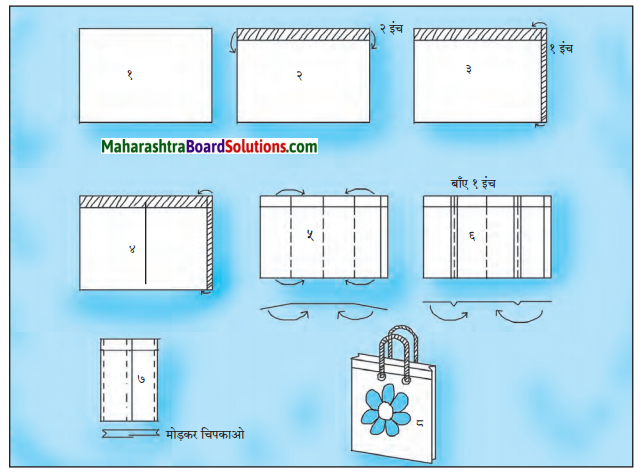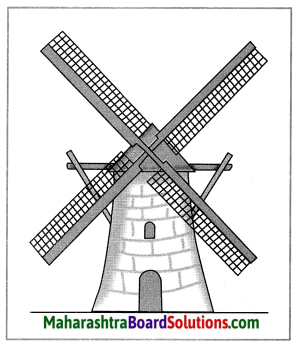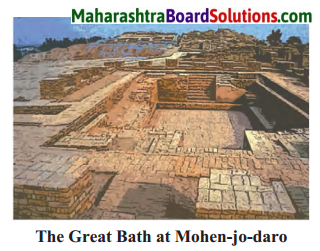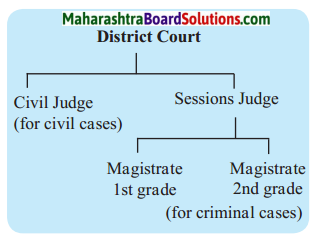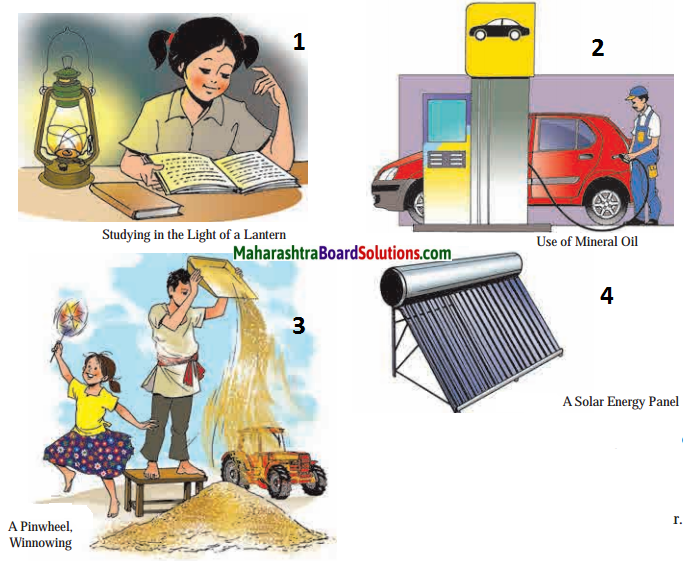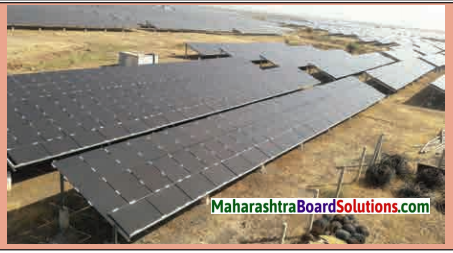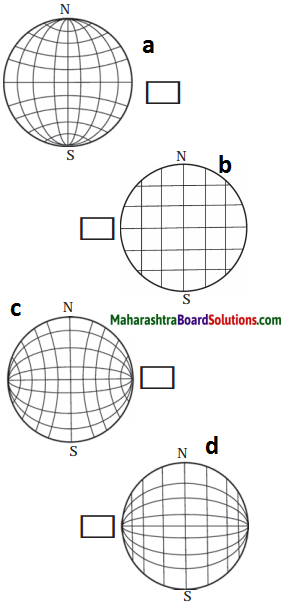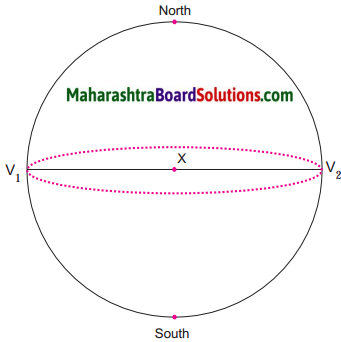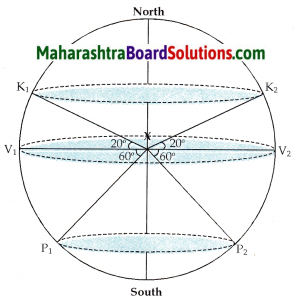Balbharti Maharashtra State Board Class 6 Marathi Solutions Sulabhbharati Chapter 6 हे खरे खरे व्हावे Notes, Textbook Exercise Important Questions and Answers.
Maharashtra State Board Class 6 Marathi Solutions Chapter 6 हे खरे खरे व्हावे… (कविता)
Marathi Sulabhbharti Class 6 Solutions Chapter 6 हे खरे खरे व्हावे Textbook Questions and Answers
1. एका-दोन वाक्यात उत्तरे लिहा.
प्रश्न अ.
कवयित्रीला अवकाशात कसे फिरावेसे वाटते?
उत्तर:
कवयित्रीला हवेवर स्वार होऊन अवकाशात पक्ष्यासारखे फिरावेसे वाटते.
प्रश्न आ.
कवयित्रीला गवतावर कसे उतरावेसे वाटते?
उत्तरः
कवयित्रीला दवबिंदू होऊन गवतावर उतरावेसे वाटते.
![]()
प्रश्न इ.
धुके बनून कवयित्रीला काय करावेसे वाटते?
उत्तर:
धुके बनून कवयित्रीला पूर्ण जग झाकून मिश्कीलतेने पहावेसे वाटते.
प्रश्न ई.
कवयित्रीला सूर्यकिरण का व्हावेसे वाटते?
उत्तर:
सूर्यकिरण काळोखाला चिरणारा असतो म्हणून कवयित्रीला सूर्यकिरण व्हावेसे वाटते.
2. खालील कल्पनेचा योग्य अर्थ शोधा.
प्रश्न अ.
सूर्यप्रकाशे वाफ होऊनी पुन्हा पुन्हा परतावे.
1. सूर्यकिरणांची वाफ व्हावी.
2. सूर्याच्या उष्णतेने वाफ बनावी.
3. सूर्याच्या उष्णतेने वाफ बनून पुन्हा दवबिंदू बनावा.
उत्तर:
सूर्य किरण होऊन काळोख नष्ट करावा.
![]()
प्रश्न आ.
भास नको मज, तुम्हा सांगतो हे खरे खरे व्हावे.
1. निसर्गातल्या रंगात रंगून जावे.
2. वर्णन केलेल्या कल्पना प्रत्यक्षात याव्यात.
3. कोणतीच गोष्ट भासमान नसावी.
उत्तर:
वर्णन केलेल्या कल्पना प्रत्यक्षात याव्यात.
3. कवितेतून शोधा. उदा., चंद्राशी खेळणारा-भरारणारा वारा
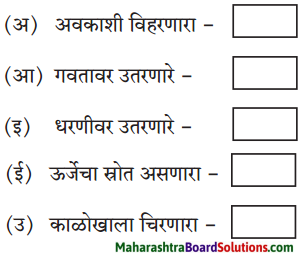
प्रश्न 1.
कवितेतून शोधा. उदा., चंद्राशी खेळणारा-भरारणारा वारा
उत्तरः
(अ) अवकाशी विहरणारा – पक्षी
(आ) गवतावर उतरणारे – दवबिंदू
(इ) धरणीवर उतरणारे – धुके
(ई) उर्जेचा स्त्रोत असणारा – सूर्य
(उ) काळोखाला चिरणारा – सूर्यकिरण
![]()
4. ‘खरे-खोटे’ याप्रमाणे काही विरुद्धार्थी शब्दांच्या जोड्या लिहा.

प्रश्न 1.
‘खरे-खोटे’ याप्रमाणे काही विरुद्धार्थी शब्दांच्या जोड्या लिहा.
उत्तरः


5. ‘मी झाड झाले तर…’ अशी कल्पना करून पाच ते सहा वाक्ये लिहा.
प्रश्न 1.
‘मी झाड झाले तर…………….’ अशी कल्पना करून पाच ते सहा वाक्ये लिहा.
उत्तर:
किती छान कल्पना आहे ही! मी झाड झाले तर पोपट, मैना, बुलबुल, कोकीळ यांच्या घरट्यांची सोय होईल. सर्व लोकांना माझ्या फळांनी तृप्त करीन. गार गार सावली देईन. जमिनीची धूप थांबवीन. सर्वप्रकारे मी मदत करीन. सर्वांत महत्त्वाचे मी टाहो फोडून सांगेन, “लोकहो! मला तोडू नका. पर्यावरण सांभाळा. तरच तुमचे जीवन सुखमय होईल.”
![]()
6. हे शब्द असेच लिहा.

प्रश्न 1.
हे शब्द असेच लिहा.

उत्तर:
क्षितिज, ऊर्जा, मिष्किल, स्रोत, स्वार, सूर्यप्रकाश, चंद्र, निसर्ग, पुन्हा.
7. ‘झुळूक मी व्हावे’ कवी दा.अ. कारे यांची कविता मिळवून, त्या कवितेचे वर्गात वाचन करा.
प्रश्न 1.
‘झुळूक मी व्हावे’ कवी दा.अ. कारे यांची कविता मिळवून, त्या कवितेचे वर्गात वाचन करा.
उत्तर:
वरील उपक्रम विद्यार्थ्यांनी स्वत: करावा.
![]()
8. ढगांचे विविध आकार काढा. त्यांना रंग द्या व त्यांत कवितेचे एकेक कडवे सुंदर अक्षरांत लिहा.
प्रश्न 1.
ढगांचे विविध आकार काढा. त्यांना रंग द्या व त्यांत कवितेचे एकेक कडवे सुंदर अक्षरांत लिहा.
9. कवयित्रीला जशी अनेक रूपे घ्यावीशी वाटतात, तसे तुम्हांला कोण कोण व्हावेसे वाटते ते लिहा.
प्रश्न 1.
कवयित्रीला जशी अनेक रूपे घ्यावीशी वाटतात, तसे तुम्हांला कोण कोण व्हावेसे वाटते ते लिहा.
उत्तर:
मला एक छोटीशी, सुंदर, नाजूक परी व्हावेसे वाटते. परी झाल्यावर मी माझ्या हातातील जादूच्या कांडीने सगळी कामे पटपट पूर्ण करेन. सगळ्यांना मदत करेन. तसेच, मला एक लेखणी (पेन) व्हावेसे वाटते. मी माझ्या शाईच्या व टोकाच्या मदतीने पांढऱ्याशुभ्र मऊ कागदावर नाचेन. त्यामुळे, सुंदर नक्षी तयार होईल किंवा कविता लिहिली जाईल. मला विमानही व्हावेसे वाटते. उंच आकाशातून उडत वेगवेगळ्या देशांत जावेसे वाटते. कधी कधी मला फुलपाखरू व्हावेसे वाटते. सुंदर, नाजूक फुलांवर बसावेसे वाटते.
![]()
10. खालील चित्र पाहा. चित्राचे वर्णन करा.
प्रश्न 1.
खालील चित्र पाहा. चित्राचे वर्णन करा.
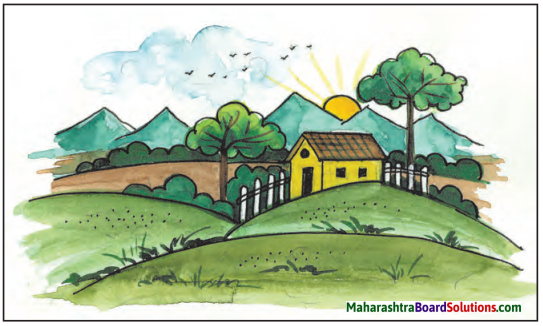
उत्तर:
हे एक सुंदर निसर्ग चित्र आहे. आकाशात ढग आहेत. पक्षी उडत आहेत. डोंगरांच्या रांगेतून सूर्योदय होत आहे. सुंदर हिरवळ, झाडे आहेत. एक टुमदार घर आहे. घराला कुंपण आहे. सकाळची प्रसन्न वेळ आहे. सर्वत्र गवत उगवले आहे. घराच्या आसपास गर्द झाडी आहे.
11. खालील वेळेला सूर्याचा रंग कसा दिसतो त्याचे निरीक्षण करा. लिहा.
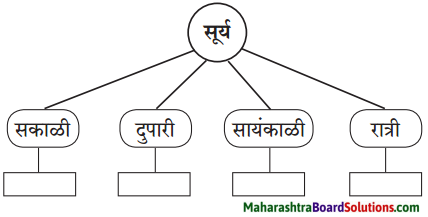
उपक्रम: तुमच्या कल्पनेने या कवितेचे वर्णन करणारे निसर्गचित्र काढा व रंगवा.
खालील वाक्यांत कंसातील योग्य सर्वनामे घाला.
(आपण, ती, त्यांनी, स्वतः)
(अ) हसिना खेळाडू आहे. …………… रोज पटांगणावर खेळते.
(आ) बाईंनी मुलांना खाऊ वाटला. …………… मुलांशी गप्पा मारल्या.
(इ) घरातील सगळे म्हणाले, “………….. सिनेमाला जाऊ.’
(ई) जॉनने ……………’ चहा केला.
खालील वाक्यांतील रिकाम्या जागी कंसातील योग्य सर्वनामे लिहा.
(अ) ……………. गावाला जा. (तुम्ही, आपण, आम्ही)
(आ) आईने …………… डबा भरून दिला. (त्याने, तिचा, आपण)
(इ) आज ……………. खूप मजा केली. (ती, स्वतः, आम्ही)
(ई) दादा धावपटू आहे. ……………. रोज पळतो. (तो, ती, त्या)
(उ) …………..” बाळाला मांडीवर घेतले. (तिला, तिने, तिचा)
(ऊ) मोत्याने धावत येऊन …………… स्वागत केले. (आम्हांला, आपण, आमचे)
प्रश्न 1.
खालील वेळेला सूर्याचा रंग कसा दिसतो त्याचे निरीक्षण करा. लिहा.

उत्तर:
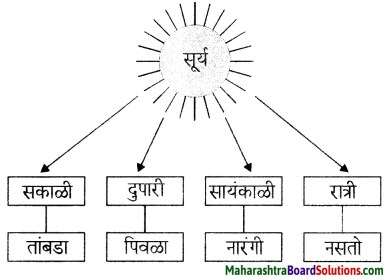
प्रश्न 2.
खालील वाक्यांत कंसातील योग्य सर्वनामे घाला.
(आपण, ती, त्यांनी, स्वतः)
(अ) हसिना खेळाडू आहे. …………… रोज पटांगणावर खेळते.
(आ) बाईंनी मुलांना खाऊ वाटला. …………… मुलांशी गप्पा मारल्या.
(इ) घरातील सगळे म्हणाले, “………….. सिनेमाला जाऊ.’
(ई) जॉनने ……………’ चहा केला.
उत्तर:
(अ) ती, (आ) त्यांनी, (इ) आपण, (ई) स्वतः
![]()
प्रश्न 3.
खालील वाक्यांतील रिकाम्या जागी कंसातील योग्य सर्वनामे लिहा.
(अ) ……………. गावाला जा. (तुम्ही, आपण, आम्ही)
(आ) आईने …………… डबा भरून दिला. (त्याने, तिचा, आपण)
(इ) आज ……………. खूप मजा केली. (ती, स्वतः, आम्ही)
(ई) दादा धावपटू आहे. ……………. रोज पळतो. (तो, ती, त्या)
(उ) …………..” बाळाला मांडीवर घेतले. (तिला, तिने, तिचा)
(ऊ) मोत्याने धावत येऊन …………… स्वागत केले. (आम्हांला, आपण, आमचे)
उत्तर:
(अ) तुम्ही, (आ) तिचा, (इ) आम्ही, (ई) तो, (उ) तिने, (ऊ) आमचे
Marathi Sulabhbharti Class 6 Solutions Chapter 6 हे खरे खरे व्हावे Important Additional Questions and Answers
खालील कल्पनेचा योग्य अर्थ शोधा.
प्रश्न 1.
काळोखाला चिरत चिरत मी सूर्य किरण व्हावा.
1. सूर्यकिरण होऊन काळोख नष्ट करावा.
2. उर्जेचा स्त्रोत पहावा.
3. सूर्याच्या प्रकाशाने उर्जा मिळावी.
उत्तर:
सूर्याच्या उष्णतेने वाफ बनून पुन्हा दवबिंदू बनावा.
![]()
खालील प्रश्नांची एक-दोन वाक्यांत उत्तरे लिहा.
प्रश्न 1.
उर्जेचा स्त्रोत कोणता आहे?
उत्तरः
सूर्य उर्जेचा स्त्रोत आहे.
प्रश्न 2.
कवयित्रीला कशात रंगून जावेसे वाटते?
उत्तर:
कवयित्रीला निसर्गातल्या रंगांमध्ये रंगून जावेसे वाटते.
प्रश्न 3.
कवितेतून शोधा.
उदा. चंद्राशी खेळणारा – भरारणारा वारा.
उत्तर:
आकाशात झुलणारा – ढग
![]()
खालील प्रश्नांची दोन-तीन वाक्यांत उत्तरे लिहा.
प्रश्न 1.
कवयित्रीला कोणकोणत्या गोष्टी खऱ्या व्हाव्यात असे वाटते?
उत्तर:
कवयित्रीला पक्षी व्हावे, दवबिंदू व्हावे, ढग होऊन झुलावे, वारा होऊन चंद्राशी खेळावे, धुक्यासारखे अलगद व्हावे, सूर्याला जवळून पहावे व निसर्गातल्या रंगांमध्ये रंगून जावे असे वाटते. या सर्व गोष्टींचा भास नको तर त्या खऱ्या व्हाव्यात असे तिला वाटते.
प्रश्न 2.
दवबिंदू कसा परतणार आहे ?
उत्तरः
सूर्यप्रकाशाने पाण्याची वाफ होईल व थंडीत पहाटे ते दवबिंदू होऊन परत गवतावर उतरतील. असाच क्रम पुन्हा-पुन्हा चालू राहील.
व्याकरण व भाषाभ्यास:
खालील वाक्यांत कंसातील योग्य सर्वनामे घाला.
(आपण, ती, त्यांनी, स्वतः, त्याला)
प्रश्न 1.
मी आणि रोहन रोज शाळेत जातो. मी जातांना हाक मारते.
उत्तर:
त्याला
![]()
प्रश्न 2.
समानार्थी शब्दांच्या जोड्या जुळवा.
| ‘अ’ गट | ‘ब’ गट |
| 1. स्वार होणे | (अ) आकाशात उडणे |
| 2. विहरणे | (आ) भ्रम |
| 3. अलगद | (इ) आरूढ होणे |
| 4. भास | (ई) हळूच |
उत्तर:
| ‘अ’ गट | ‘ब’ गट |
| 1. स्वार होणे | (इ) आरूढ होणे |
| 2. विहरणे | (अ) आकाशात उडणे |
| 3. अलगद | (ई) हळूच |
| 4. भास | (आ) भ्रम |
प्रश्न 3.
खालील शब्दांचा, वाक्प्रचारांचा वाक्यांत उपयोग करा.
उत्तर:
- मिश्कील – लहान मुले मिश्कील असतात.
- स्वार होणे – राजा घोड्यावर स्वार होऊन शिकारीला निघाला.
- अलगद – सीमाने काचेचे भांडे अलगद जमिनीवर ठेवले.
- काळोखाला चिरणे – बॅटरीचा झोत काळोखाला चिरत होता.
- विहरणे – पक्षी आनंदात आकाशात विहरतात.
![]()
लेखन विभाग:
प्रश्न 1.
खालील चित्र पहा. चित्राचे वर्णन करा.
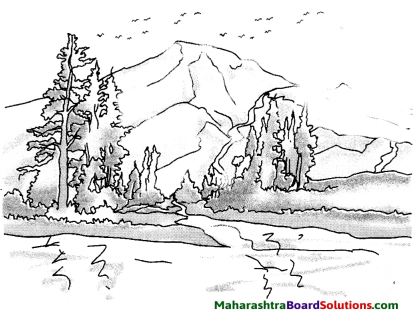
उत्तर:
काश्मीरचे निसर्ग सौंदर्य
चित्रात हिमालयाच्या रांगा आहेत. त्यावर पांढराशुभ्र बर्फ आहे. देवदारचे उंच उंच वृक्ष आहेत. धबधब्याचे पाणी पडत आहे. पक्षी उडत आहेत. निसर्ग सौंदर्य अप्रतिम आहे.
![]()
प्रश्न 2.
मी झाड झाले तर ………… अशी कल्पना करून पाच ते सहा वाक्ये लिहा.
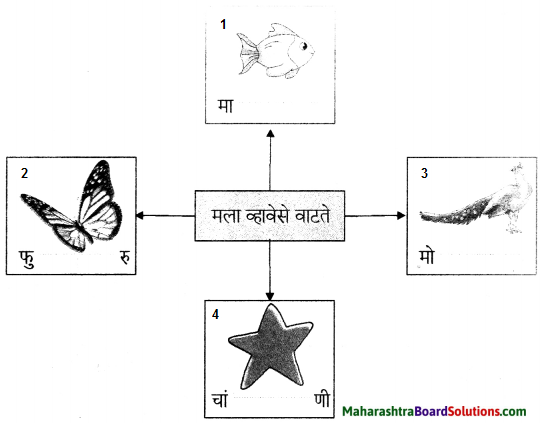
उत्तर:
1 – मासा
2 – फुलपाखरु
3 – मोर
4 – चांदणी
हे खरे खरे व्हावे Summary in Marathi
काव्यपरिचयः
प्रस्तुत कवितेत कवयित्रीच्या मनातील विचार खरे खरे व्हावे, असे तिला वाटते. पक्षी व्हावे, दवबिंदू व्हावे, चंद्राशी खेळावे, | सूर्याला जवळून पहावे अशा अनेक अशक्य गोष्टी करता याव्या, असे तिला वाटते. निसर्गातील रंगांमध्ये रंगून जाण्याची तिची इच्छा आहे.
![]()
शब्दर्थ:
- स्वार होणे – आरूढ होणे (to ride on)
- विहरणे – आकाशात उडणे (to fly)
- पक्षी – खग (bird)
- दवबिंदू – पानावरील पाण्याचा थेंब (dew drops)
- क्षितिज – आकाश जेथे जमिनीला टेकल्याचा भास होतो ती रेषा (horizon)
- गडद – भडक (dark)
- भरारणारा – वेगात वाहणारा (violent vind)
- धुके – (fog, mist)
- अलगद – हळूच (softly)
- धरणी – जमीन (land)
- मिश्कील – खोडकर (naughty, mischievous)
- उर्जा – उष्णता (energy)
- भास – भ्रम (illusion)
- स्त्रोत – जेथून मिळते तो मार्ग (source)
वाक्प्रचार व अर्थ :
1. काळोखाला चिरणे – काळोख भेदून जाणे.
